Study tour of the countries within Southeast
Asia, undertaken by a group from Maharshi Adhyatma
University under the guidance of Sadguru Mrs. Anjali Gadgil
The land which was referenced as Kambhoj country in Mahabharat, is todays Cambodia! Hindus resided here till 15th century. It is said that Hindu empire by the name Khmer ruled Cambodia from 802 AD till 1421 AD. In reality, Kambhoj region was Sage Koudinya’s area. Also, Kambhoj region was also a region of Nagas. As per references available, the King of Kambhoj had also participated in the war of Mahabharat. Being a region of Nagas, this is also the region of Deity Shiva and it is said that Shrivishnu’s vehicle Garud resides on Mahendra mountain. Therefore this is also a region of Shrivishnu. This article details few highlights of the study tour conducted by Sadguru Mrs. Anjali Gadgil and 4 student seekers of Maharshi Adhyatma University, in this Kambhoj country, the region of Harihar.
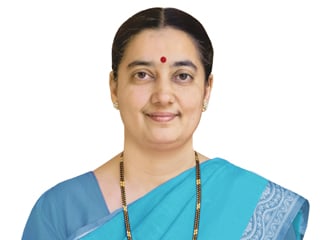
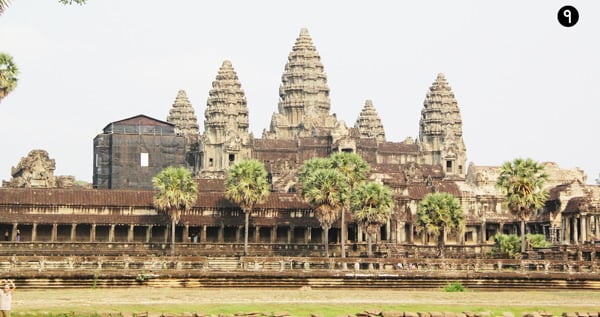
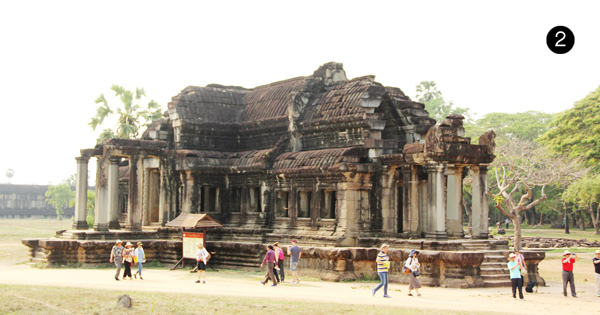
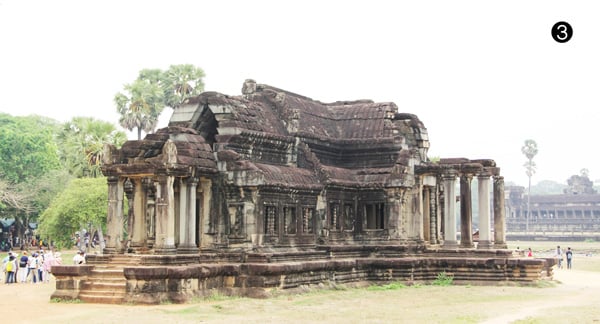
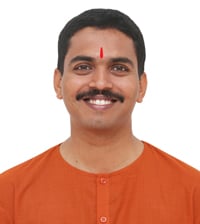
1. Hindu King Yashovarman who established Angkor city had
named it as Yashodharpura and later King Suryavarman II from his lineage
built a huge temple as Bhagwan Shrivishnu’s abode in the centre of the Angkor city
World’s largest temple of Hindus is situated in Cambodia and not in India where Hindus are in majority. The name of this temple is Angkor Wat! In order to visit the temple, on 25th March we travelled by flight from Cambodia’s capital city of Phnom penh to the city of Siem Reap in North Cambodia, along with Sadguru Mrs. Anjali Gadgil. This temple is situated at a distance of 6 kilometres from Siem Reap and it takes one full day to view the temple and its premises.
Hindu King Yashovarman had established the city of Angkor Wat in 9th century and it was named as Yashodharpura in those times. Later his descendant, King Suryavarman II built a huge temple of Bagwan Shrivishnu in the centre of the city (see picture 1). The original name of the temple was Paramvishnulok! Now in the regional language, it is called as Angkor Wat. ‘Angkor’ means city and ‘Wat’ means garden. Since this temple is situated in the centre of the city, it would have acquired this name. In those times, the Hindu Kings had spiritual emotion that this temple is a sacred dwelling of Srivishnu and that the King is the servitor of Shrivishnu. They also believed that Shrivishnu Himself takes care of upkeep and nourishment of the citizens. The citizens however carried a spiritual emotion that the King himself is a form of Shrivishnu.
2. Presence of eight handed idol of Shrivishnu on
top of the main entrance of Angkor Wat temple in the centre
with idol of Deity Brahma on its left and idol of Deity Shiva on its right
Premises of the Angkor Wat temple is spread over 402 acres of land. The temple is surrounded by water from all the sides and there are 20 feet deep trenches. On walking over the bridge, built over the trench located on west side of the temple, at a distance of about 200 metres the main entrance is located. On the main entrance, in the centre an eight handed idol of Shrivishnu is present with Deity Brahma’s idol on its left and Deity Shiva’s idol on its right side. There are 2 huge doors, one on the left and other on the right side of the main entrance. These are called as ‘Elephant doors’. These were used for elephants to enter and exit.
3. Presence of Shiva-Brahma library and Shiva-Vishnu library in
the premises of the temple with facility of books for devotees to learn Vedas,
study holy texts related to Vedas and aspects related to worship, in those times
Upon walking for about 100 metres from the main entrance of the temple, there is one library located on the left and one on the right side. The library located on the left side is named as ‘Shiva-Brahma’ library and the one located on the right side is named as ‘Shiva-Vishnu’ library. In those times, both the libraries contained books for devotees to learn Vedas, other holy texts related to Vedas and books for studying aspects related to worship in the temple. In short, this place was a school for imparting knowledge on Vedas and a Gurukul (refer to the photos 2 and 3).
Reinstallation of the head of the huge idol of Shrivishnu
situated in the temple which was ruined by the looters, based on the
advice given by person having divine impersonation, by the Cambodia government
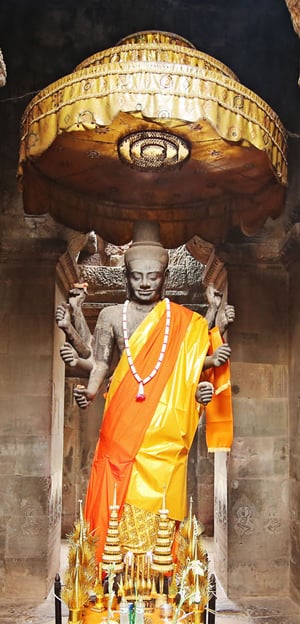
Increase in the number of tourists after the re-installation
of head of the Shrivishnu idol broken by the looters in the year 1984!
Cambodian government immediately implements the solution given by a spiritually evolved person, however in India, under the pretext of secularism, the solutions recommended by Saints are ignored, which is shameful for Indian government!
In India, if this happens, ANS will definitely demand that the person claiming to have Divine impersonation is arrested and put in the jail. One should understand the spiritual science behind everything that happens and everyone, not just the government, should think about what is essential for the well-being of the nation. Only then Hindu nation would be established in real sense.
Out of the 3 gopurs (Monumental gatehouse tower) connected to the main entrance on the west side of the Angkor Wat temple, the gopur on the right hand side still has a huge eight handed idol of Shrivishnu (look at the picture above). Based on the information shared by a local learned person, this idol was found by French archaeological department while performing excavation in 1880. During the Cambodian civil war which happened in 1984, few looters broke the head of the idol and tried to escape with it. During this attack the head fell on the floor and surprisingly they were unable to lift it. Therefore they had to flee leaving the head of the idol on the floor itself. Later this head was preserved in the museum till the year 2004.
Yearly spiritual festival is held in Angkor Wat temple. During one such festival, a person with Divine infusion advised, “The head of the idol of Shrivishnu has to be reinstalled as it was before. Because of the headless idol standing in the temple, the nation is faced with divine disgrace.” Therefore due to the demand made by the local citizens, the Cambodian government reinstalled the head of Shrivishnu on its idol. The very next year, in 2005, Cambodia witnessed steep increase in the tourists, visiting the nation, to about 20 lacs. Earlier the number of tourists visiting Cambodia was quite less. By reinstalling the head of the broken idol, Cambodia reaped huge benefits. Local citizens have a firm belief that only because the head was reinstalled on the idol of Shrivishnu, all good things started to happen.
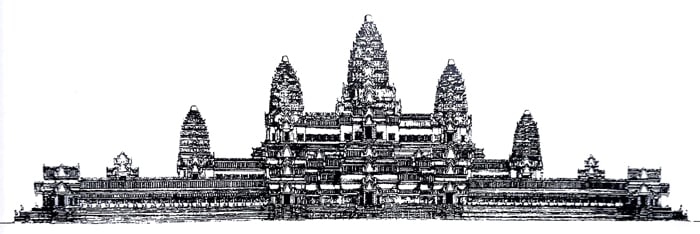
4. Multiple sculptures being sculpted on all the four walls of the temple atrium
When one walks forward from the library situated in the temple premises, for about 200 metres the main temple can be located. This is the west side entrance of the temple. The first court of the temple starts at this point. There are 4 atriums on all the four sides of the court. The walls of all the four atriums, 4 corners and the walls of all the four entrances in four directions are decorated with sculptures of Deities carved on them. The design of ornaments carved on the sculptures of Deities are very fine and exceptional. One can even see the different hair styles on these sculptures. The entrance doors have beautiful designs of flowers carved on them. Each entrance and the sanctum sanctorum have steps in steep vertical direction and not in slanting direction as it is usually. One cannot imagine how the people would be daily performing the ritualistic worship (refer to the below picture number 1). Lakhs of huge stones have been used to construct the temple. As suggested by our guide, these stones would probably have been transported through the river flowing behind Mahendra mountain which is about 70 kilometres from this place.

5. For sides of Angkor Wat temple and the sculptures carved on them
A. South-east corner : These sculptures depict the scenarios of churning of ocean, Deity Yama giving punishment, and scenes from Heaven and Hell regions.
B. South-west corner in the temple : Many sculptures are carved here. These include scenarios depicting Divine plays of Shrikrushna, various scenes such as Vali’s assassination by Prabhu Shriram, Ravan lifting Kailash mountain, churning of ocean, Prabhu Shriram chasing the daemon Marich, Deity Shiva in the form of Dakshinamurty, Shrikrushna lifting Govardhan mountain, Kamdev’s assassination by Deity Shiva, Deity Shiva meditating and Bhagwan Shrivishnu listening to words of praises from other Deities in Vaikuntha region.
C. North-west corner : Scenes like Shrikrushna defeating daemon Banasur, Shrivishnu winning the battle against daemons etc., are carved with the sculptures in this side.
D. North-east corner of the temple : There are multiple sculptures here depicting scenes of Devi Sita entering fire to prove that she is chaste, Shriram returning to Ayodhya after slaying Ravan, discussion between Shriram, Lakshman and Bibhishan, Hanuman giving Shriram’s ring to Devi Sita, Shrivishnu relaxing on serpent Shesh and Deities putting forth their issues to Him, battle between Deities and daemons, Shriram and Lakshman discussing with Sugreev, Shriram and Lakshman fighting against daemon Kadambh and marriage of Devi Sita.
6. Angkor Wat’s main temple and sanctum sanctorum

One has to climb upstairs from the second atrium within the Angkor Wat temple to reach the last atrium. Here one can see the main temple with 5 gopur-like crowns. These 5 crowns are akin to 5 peaks of sacred Meru mountain. (Our guide informed us that the 5 crowns of the main Angkor Wat temple, 4 crowns present on the 4 sides of the temple, and the 3 crowns near the main entrance door of the temple totals to 12 crowns and these symbolize 12 Jyotirlingas. The 3 crowns near the main entrance door do not exist today.) There is a sanctum sanctorum in the centre of the temple having 5 crowns. The 5th crown is on top of the sanctum sanctorum. One has to climb steep and high steps to reach the sanctum sanctorum (see the picture 2). From sanctum sanctorum, one can see the main entrance door which is located at a distance of 750 metres. The vastness of the temple and its premises as seen from the sanctum sanctorum cannot be described in words.
Gratitude
By the grace of Paratpar Guru Dr. Athavale, we could visit the world’s biggest Hindu temple and learn various aspects about the temple. The seekers from this study tour express millions of gratitude unto the holy feet of Paratpar Guru Dr. Athavale and Sadguru Mrs. Anjali Gadgil for providing us this opportunity.
– Shri. Vinayak Shanbag, Cambodia
Millions of gratitude unto the feet of Sadguru Mrs. Anjali Gadgil for travelling untiringly and collecting precious aspects of Hindu culture from across the globe for Maharshi Adhyatma University and unto Paratpar Guru Dr. Athavale for providing valuable guidance for this cause!

 In spite of presently being a Buddhist nation, traditional folk dance ‘Apsara Nrutya’ of Cambodia...
In spite of presently being a Buddhist nation, traditional folk dance ‘Apsara Nrutya’ of Cambodia... During war, Cambodian kings provided sacred threads to soldiers for their protection
During war, Cambodian kings provided sacred threads to soldiers for their protection Bayon temple built in Angkor Thom region of Cambodia representing Buddhism and Hinduism
Bayon temple built in Angkor Thom region of Cambodia representing Buddhism and Hinduism Ta Prohm temple, Cambodia built by King Jayavarman VII for his mother at the end...
Ta Prohm temple, Cambodia built by King Jayavarman VII for his mother at the end... Banteay Srei : The Deity Shiva temple in Phnom Dei village, Cambodia
Banteay Srei : The Deity Shiva temple in Phnom Dei village, Cambodia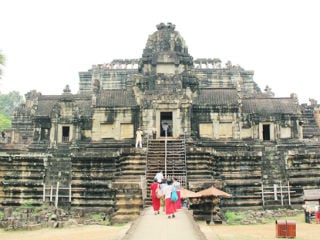 Bapun temple built by King Udayadityavarman II of Yashodharpura
Bapun temple built by King Udayadityavarman II of Yashodharpura